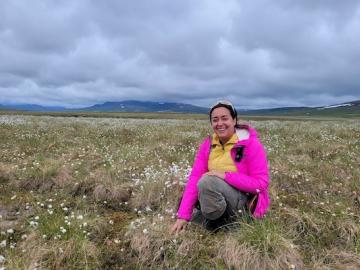Filter News
Area of Research
- (-) Biology and Environment (44)
- (-) National Security (16)
- Advanced Manufacturing (1)
- Chemistry and Physics at Interfaces (1)
- Clean Energy (78)
- Data (1)
- Energy Frontier Research Centers (1)
- Functional Materials for Energy (1)
- Fusion and Fission (7)
- Isotope Development and Production (1)
- Isotopes (9)
- Materials (34)
- Materials Synthesis from Atoms to Systems (1)
- Materials Under Extremes (1)
- Neutron Science (8)
- Nuclear Science and Technology (5)
- Renewable Energy (1)
- Sensors and Controls (1)
- Supercomputing (9)
News Type
News Topics
- 3-D Printing/Advanced Manufacturing (1)
- Artificial Intelligence (2)
- Big Data (1)
- Bioenergy (10)
- Biology (17)
- Biomedical (4)
- Biotechnology (2)
- Chemical Sciences (3)
- Clean Water (4)
- Climate Change (7)
- Composites (1)
- Computer Science (4)
- Coronavirus (2)
- Cybersecurity (4)
- Decarbonization (4)
- Energy Storage (1)
- Environment (23)
- Exascale Computing (1)
- Grid (1)
- High-Performance Computing (5)
- Hydropower (2)
- Machine Learning (3)
- Materials (1)
- Materials Science (2)
- Mathematics (2)
- Mercury (3)
- Microscopy (4)
- National Security (10)
- Net Zero (1)
- Nuclear Energy (1)
- Physics (1)
- Polymers (1)
- Quantum Science (1)
- Security (2)
- Simulation (3)
- Summit (1)
- Sustainable Energy (6)
Media Contacts

Though Scott Stewart recently received an Early Career Award from the Institute of Nuclear Material Management, he is regarded as a seasoned professional in the nuclear field with over 10 years of experience.

With wildfires increasing in scope and intensity around the world, Fernanda Santos’ research into how such calamities affect soil carbon storage has taken on new urgency.

Countries around the world have unique languages, cultures, food, entertainment and governments. Yet, more than 170 countries are finding common ground in an unlikely field: nuclear material and science.

When Matt McCarthy saw an opportunity for a young career scientist to influence public policy, he eagerly raised his hand.

Cameras see the world differently than humans. Resolution, equipment, lighting, distance and atmospheric conditions can impact how a person interprets objects on a photo.

Chemical and environmental engineer Samarthya Bhagia is focused on achieving carbon neutrality and a circular economy by designing new plant-based materials for a range of applications from energy storage devices and sensors to environmentally friendly bioplastics.

Though Nell Barber wasn’t sure what her future held after graduating with a bachelor’s degree in psychology, she now uses her interest in human behavior to design systems that leverage machine learning algorithms to identify faces in a crowd.

Science has taken Melanie Mayes from Tennessee to the tropics, studying some of the most important ecosystems in the world.

How an Alvin M. Weinberg Fellow is increasing security for critical infrastructure components

Jennifer Morrell-Falvey’s interest in visualizing the science behind natural processes was what drew her to ORNL in what she expected to be a short stint some 18 years ago.




